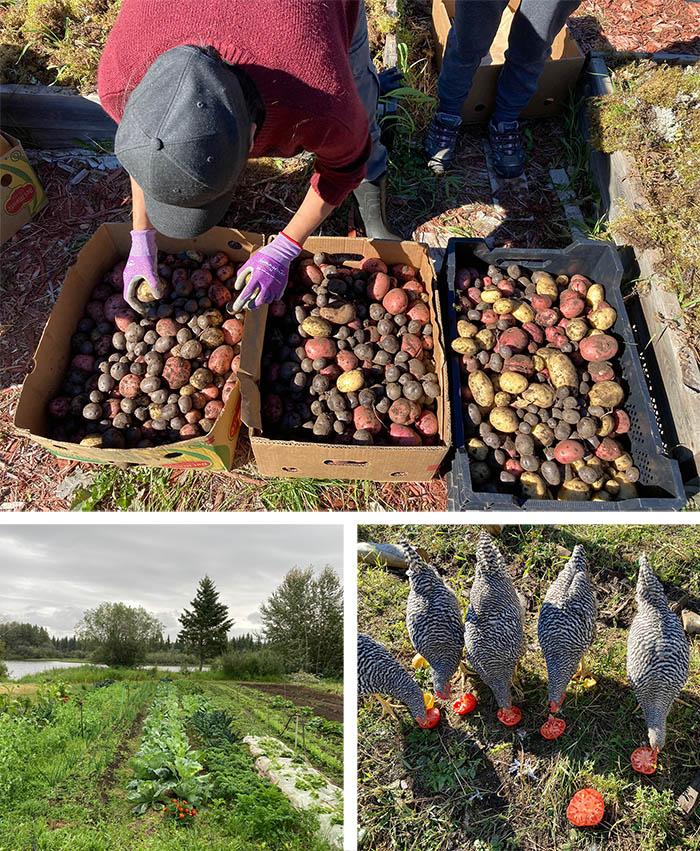By: Mindy Jewell Price, PhD Candidate at the University of California at Berkeley
Relative to elsewhere on the North American continent, agriculture does not have deep roots in the Arctic and Subarctic, but the sector is growing quickly.
In Alaska and in northern Canada, where I conduct my NSF-supported PhD research, Indigenous peoples are traditionally hunters and gatherers, and they practice reciprocal relationship with the land, animals, and waters for physical and spiritual nourishment. Agriculture in the North American Arctic first emerged with fur trappers and traders in the early 1800s, and small-scale farming boomed briefly around mining towns in the early twentieth century (Piper and Sandlos 2007; Robbinson 2010; Stevenson et al. 2014). The history of agriculture in Subarctic and Arctic North America is also entangled in the assimilation curriculum of residential school programs, whose aim was to transform Indigenous peoples from hunters and gatherers to agricultural producers (Rudolph and McLachlan 2013).
Over the last decade, there has been increased interest and investment in Arctic agriculture. Regional and state governments are infusing money and supportive policies into the sector (Unc et al. 2021), for example, the state of Alaska is currently working to develop 100,000-plus acres of agricultural land through the Nenana-Totchaket Project. Some Indigenous communities are beginning to develop small-scale garden projects (Johnston and Spring 2021) and new farming methods and commercial crops, such as vertical farming and cannabis production, are immigrating north. A warming climate also supports new opportunities for circumpolar agricultural production through an extended growing season with warmer air and soil temperatures (Hannah et al. 2020; King et al. 2018).


Agricultural cultivation in the Arctic holds alluring promise. Recent research suggests that the growth of the northern agricultural sector may contribute to local and regional food security and food self-sufficiency (Unc et al. 2021). Agricultural production could support local livelihoods (Lemay et al. 2021; Stevenson et al. 2020). Furthermore, crop cultivation may help Indigenous communities adapt their food systems to climate change as traditional food provisioning is under climate threat (Ahmed and Wenman 2020). For other Indigenous northerners, local food production helps reduce dependence on a colonial food system built around imported food (Spiegelaar and Tsuji 2013).
However, agricultural development in the North American North has historically contributed to the loss of Indigenous food sovereignty through ecosystem degradation, loss of traditional harvesting practices, and an increased reliance on food imports (Piper and Sandlos 2007; Spiegelaar & Tsuji 2013). Unchecked, agricultural development in new frontiers can lead to rapid expansion of large-scale capitalized agriculture, which has contributed to deforestation, loss of biodiversity, loss of traditional livelihoods, and increased food insecurity around the world (Meyfroidt 2021).
For these reasons, my colleagues and I look to circumpolar northern agricultural development with tempered optimism and propose a uniquely northern framework for Arctic agroecology. Agroecology, typically associated with existing agricultural systems in temperate and tropical regions, is a science of applying ecological concepts to food systems management that uses a set of ecologically friendly, organic, or alternative agriculture practices. It is an alternative to the global agriculture system that prioritizes maximum yields over other social, cultural, and environmental objectives including food sovereignty, ecosystem health, and sustainable, local livelihoods (Price et al. 2022). We suggest that agroecology's tools of science, practice, and social movement are well-adapted to a northern context—and might possibly guide development while occluding the damaging trajectory of other agricultural frontiers.

The outline of our proposed framework includes five key components of northern agroecology: stewardship, economies, knowledge, social dimensions, and governance. Rather than a direct focus on agricultural practices, we think broadly about environmental stewardship. Instead of emphasizing supporting local livelihoods, we recognize the importance of multiple economies that include sharing and trading. Knowledge networks involve generational knowledge transmission, as well as between communities and across epistemologies. Language and spirituality are important social dimensions. Most importantly, a northern agroecological framework brings Indigenous land and food sovereignty to the center of the discussion around agricultural development, encouraging creative and just governance models.

Agroecology builds on traditional and local knowledge and utilizes sustainable, ecosystem-centered agricultural practices. While many Arctic and Subarctic Indigenous peoples have no traditional agricultural practices, other forms of environmental stewardship align closely with an agroecological orientation. In the Northwest Territories, Canada, for example, in addition to cultivating a robust diversified garden, members of Sambaa K'e First Nation steward their land through sustainable hunting, fishing, and harvesting. They do continuous monitoring of the forest, rivers, and lakes to prevent over-harvesting, similar to agroecological practices that minimize ecological damage through diversified systems and reducing or eliminating the use of pesticides. Other northerners have practiced sustainable small-scale agriculture for several generations, such as farmers in Paradise Gardens, who have cultivated market gardens, potatoes, berries, hay, and eggs for more than seventy years. Connecting diverse northern communities to share knowledge about sustainable agriculture practices and other forms of environmental stewardship are key to developing and protecting fragile boreal and Arctic ecosystems.
With climate change, rising inflation, and other social and cultural changes, agriculture is increasing in the Subarctic and Arctic. Farms are growing in both number and size. Now is the time to invest in the science, practice, and movement of northern agroecology. Doing so can protect the Arctic and Subarctic from the devastating effects of conventional agriculture, and help the North become of model of regenerative and restorative food systems.
For further information, please see, "Op-ed: Climate Change Is Bringing Agriculture to the Arctic. Let's Prioritize Food Sovereignty", and "Agroecology in the North: Centering Indigenous food sovereignty and land stewardship in agriculture 'frontiers'" .
References
Ahmed, R., and C. Wenman. 2020. Ka'a'gee Tu First Nation and Sambaa K'e First Nation Climate Change Workshop Report: February 11-13, 2020- Kakisa, NT. Yellowknife, NT: PlanIt North.
Johnston, C. and A. Spring. 2021. Grassroots and Global Governance: Can Global-Local Linkages Foster Food System Resilience for Small Northern Canadian Communities? Sustainability 13: 2415. https://doi.org/10.3390/su13042415
King, M., D. Altdorff, P. Li, L. Galgedara, J. Holden, and A. Unc. 2018. Northward Shift of the Agricultural Climate Zone Under 21st-Century Global Climate Change. Scientific Reports 8. https://doi.org/10.1038/s41598-018-26321-8
Lemay, M. A., J. Radcliffe, D. Bysouth, & A. Spring. 2021. Northern Food Systems in Transition: The Role of the Emerging Agri-Food Industry in the Northwest Territories (Canada) Food System. Frontiers in Sustainable Food Systems 5. https://doi.org/10.3389/fsufs.2021.661538
Meyfroidt, P. 2021. "Emerging Agricultural Expansion in Northern Regions: Insights from Land-use Research." One Earth 4: 1661–1664.
Piper, L., & J. Sandlos. 2007. A Broken Frontier: Ecological Imperialism in the Canadian North. Environmental History 12: 759–95.
Price, M. J., A. Latta, A. Spring, J. Temmer, C. Johnston, L. Chicot, J. Jumbo, and M. Leishman. 2022. Agroecology in the North: Centering Indigenous Food Sovereignty and Land Stewardship in Agriculture "Frontiers." Agriculture and Human Values. https://link.springer.com/article/10.1007/s10460-022-10312-7.
Robbinson, S. 2010. Humble Dreams: An Historical Perspective on Yukon Agriculture Since 1846. The Northern Review 32: 135–167.
Rudolph, K. R. and S. M. McLachlan. 2013. Seeking Indigenous Food Sovereignty: Origins of and Responses to the Food Crisis in Northern Manitoba, Canada. Local Environment 18(9).
https://doi.org/10.1080/13549839.2012.754741
Stevenson, K. T., L. Alessa, A. D. Kliskey, H. B. Rader, A. Pantoja, M. Clark, & N. Giguére. 2014. Sustainable Agriculture for Alaska and the Circumpolar North: Part I. Development and Status of Northern Agriculture and Food Security. Arctic 67 (3): 271–295.
About the Author
 As a PhD Candidate at the University of California at Berkeley, Mindy Jewell Price uses ethnographic and archival methods to study the social and political processes that affect the design, management, and impacts of agricultural development in the Northwest Territories, Canada. Her research explores the ways in which people who cultivate food are positioned with respect to each other in forces beyond their individual control—the corporate food regime, settler colonialism, climate change, and evolving policies of land control and use. Her ongoing work is supported by an NSF Arctic Doctoral Dissertation Research Improvement Grant.
As a PhD Candidate at the University of California at Berkeley, Mindy Jewell Price uses ethnographic and archival methods to study the social and political processes that affect the design, management, and impacts of agricultural development in the Northwest Territories, Canada. Her research explores the ways in which people who cultivate food are positioned with respect to each other in forces beyond their individual control—the corporate food regime, settler colonialism, climate change, and evolving policies of land control and use. Her ongoing work is supported by an NSF Arctic Doctoral Dissertation Research Improvement Grant.
